Chapter 9 Review Exercises
- Page ID
- 18881
Chapter Review Exercises
Solve Quadratic Equations Using the Square Root Property
In the following exercises, solve using the Square Root Property.
- \(y^{2}=144\)
- \(n^{2}-80=0\)
- \(4 a^{2}=100\)
- \(2 b^{2}=72\)
- \(r^{2}+32=0\)
- \(t^{2}+18=0\)
- \(\frac{2}{3} w^{2}-20=30\)
- \(5 c^{2}+3=19\)
- Answer
-
1. \(y=\pm 12\)
3. \(a=\pm 5\)
5. \(r=\pm 4 \sqrt{2} i\)
7. \(w=\pm 5 \sqrt{3}\)
In the following exercises, solve using the Square Root Property.
- \((p-5)^{2}+3=19\)
- \((u+1)^{2}=45\)
- \(\left(x-\frac{1}{4}\right)^{2}=\frac{3}{16}\)
- \(\left(y-\frac{2}{3}\right)^{2}=\frac{2}{9}\)
- \((n-4)^{2}-50=150\)
- \((4 c-1)^{2}=-18\)
- \(n^{2}+10 n+25=12\)
- \(64 a^{2}+48 a+9=81\)
- Answer
-
1. \(p=-1,9\)
3. \(x=\frac{1}{4} \pm \frac{\sqrt{3}}{4}\)
5. \(n=4 \pm 10 \sqrt{2}\)
7. \(n=-5 \pm 2 \sqrt{3}\)
Solve Quadratic Equations by Completing the Square
In the following exercises, complete the square to make a perfect square trinomial. Then write the result as a binomial squared.
- \(x^{2}+22 x\)
- \(m^{2}-8 m\)
- \(a^{2}-3 a\)
- \(b^{2}+13 b\)
- Answer
-
1. \((x+11)^{2}\)
3. \(\left(a-\frac{3}{2}\right)^{2}\)
In the following exercises, solve by completing the square.
- \(d^{2}+14 d=-13\)
- \(y^{2}-6 y=36\)
- \(m^{2}+6 m=-109\)
- \(t^{2}-12 t=-40\)
- \(v^{2}-14 v=-31\)
- \(w^{2}-20 w=100\)
- \(m^{2}+10 m-4=-13\)
- \(n^{2}-6 n+11=34\)
- \(a^{2}=3 a+8\)
- \(b^{2}=11 b-5\)
- \((u+8)(u+4)=14\)
- \((z-10)(z+2)=28\)
- Answer
-
1. \(d=-13,-1\)
3. \(m=-3 \pm 10 i\)
5. \(v=7 \pm 3 \sqrt{2}\)
7. \(m=-9,-1\)
9. \(a=\frac{3}{2} \pm \frac{\sqrt{41}}{2}\)
11. \(u=-6 \pm 2 \sqrt{2}\)
Solve Quadratic Equations of the Form \(ax^{2}+bx+c=0\) by Completing the Square
In the following exercises, solve by completing the square.
- \(3 p^{2}-18 p+15=15\)
- \(5 q^{2}+70 q+20=0\)
- \(4 y^{2}-6 y=4\)
- \(2 x^{2}+2 x=4\)
- \(3 c^{2}+2 c=9\)
- \(4 d^{2}-2 d=8\)
- \(2 x^{2}+6 x=-5\)
- \(2 x^{2}+4 x=-5\)
- Answer
-
1. \(p=0,6\)
3. \(y=-\frac{1}{2}, 2\)
5. \(c=-\frac{1}{3} \pm \frac{2 \sqrt{7}}{3}\)
7. \(x=\frac{3}{2} \pm \frac{1}{2} i\)
In the following exercises, solve by using the Quadratic Formula.
- \(4 x^{2}-5 x+1=0\)
- \(7 y^{2}+4 y-3=0\)
- \(r^{2}-r-42=0\)
- \(t^{2}+13 t+22=0\)
- \(4 v^{2}+v-5=0\)
- \(2 w^{2}+9 w+2=0\)
- \(3 m^{2}+8 m+2=0\)
- \(5 n^{2}+2 n-1=0\)
- \(6 a^{2}-5 a+2=0\)
- \(4 b^{2}-b+8=0\)
- \(u(u-10)+3=0\)
- \(5 z(z-2)=3\)
- \(\frac{1}{8} p^{2}-\frac{1}{5} p=-\frac{1}{20}\)
- \(\frac{2}{5} q^{2}+\frac{3}{10} q=\frac{1}{10}\)
- \(4 c^{2}+4 c+1=0\)
- \(9 d^{2}-12 d=-4\)
- Answer
-
1. \(x=\frac{1}{4}, 1\)
3. \(r=-6,7\)
5. \(v=\frac{-1 \pm \sqrt{21}}{8}\)
7. \(m=\frac{-4 \pm \sqrt{10}}{3}\)
9. \(a=\frac{5}{12} \pm \frac{\sqrt{23}}{12} i\)
11. \(u=5 \pm \sqrt{21}\)
13. \(p=\frac{4 \pm \sqrt{5}}{5}\)
15. \(c=-\frac{1}{2}\)
In the following exercises, determine the number of solutions for each quadratic equation.
-
- \(9 x^{2}-6 x+1=0\)
- \(3 y^{2}-8 y+1=0\)
- \(7 m^{2}+12 m+4=0\)
- \(5 n^{2}-n+1=0\)
-
- \(5 x^{2}-7 x-8=0\)
- \(7 x^{2}-10 x+5=0\)
- \(25 x^{2}-90 x+81=0\)
- \(15 x^{2}-8 x+4=0\)
- Answer
-
1.
- \(1\)
- \(2\)
- \(2\)
- \(2\)
In the following exercises, identify the most appropriate method (Factoring, Square Root, or Quadratic Formula) to use to solve each quadratic equation. Do not solve.
-
- \(16 r^{2}-8 r+1=0\)
- \(5 t^{2}-8 t+3=9\)
- \(3(c+2)^{2}=15\)
-
- \(4 d^{2}+10 d-5=21\)
- \(25 x^{2}-60 x+36=0\)
- \(6(5 v-7)^{2}=150\)
- Answer
-
1.
- Factor
- Quadratic Formula
- Square Root
Solve Equations in Quadratic Form
In the following exercises, solve.
- \(x^{4}-14 x^{2}+24=0\)
- \(x^{4}+4 x^{2}-32=0\)
- \(4 x^{4}-5 x^{2}+1=0\)
- \((2 y+3)^{2}+3(2 y+3)-28=0\)
- \(x+3 \sqrt{x}-28=0\)
- \(6 x+5 \sqrt{x}-6=0\)
- \(x^{\frac{2}{3}}-10 x^{\frac{1}{3}}+24=0\)
- \(x+7 x^{\frac{1}{2}}+6=0\)
- \(8 x^{-2}-2 x^{-1}-3=0\)
- Answer
-
1. \(x=\pm \sqrt{2}, x=\pm 2 \sqrt{3}\)
3. \(x=\pm 1, x=\pm \frac{1}{2}\)
5. \(x=16\)
7. \(x=64, x=216\)
9. \(x=-2, x=\frac{4}{3}\)
Solve Applications of Quadratic Equations
In the following exercises, solve by using the method of factoring, the square root principle, or the Quadratic Formula. Round your answers to the nearest tenth, if needed.
- Find two consecutive odd numbers whose product is \(323\).
- Find two consecutive even numbers whose product is \(624\).
- A triangular banner has an area of \(351\) square centimeters. The length of the base is two centimeters longer than four times the height. Find the height and length of the base.
- Julius built a triangular display case for his coin collection. The height of the display case is six inches less than twice the width of the base. The area of the of the back of the case is \(70\) square inches. Find the height and width of the case.
- A tile mosaic in the shape of a right triangle is used as the corner of a rectangular pathway. The hypotenuse of the mosaic is \(5\) feet. One side of the mosaic is twice as long as the other side. What are the lengths of the sides? Round to the nearest tenth.

Figure 9.E.1
6. A rectangular piece of plywood has a diagonal which measures two feet more than the width. The length of the plywood is twice the width. What is the length of the plywood’s diagonal? Round to the nearest tenth.
7. The front walk from the street to Pam’s house has an area of \(250\) square feet. Its length is two less than four times its width. Find the length and width of the sidewalk. Round to the nearest tenth.
8. For Sophia’s graduation party, several tables of the same width will be arranged end to end to give serving table with a total area of \(75\) square feet. The total length of the tables will be two more than three times the width. Find the length and width of the serving table so Sophia can purchase the correct size tablecloth . Round answer to the nearest tenth.
9. A ball is thrown vertically in the air with a velocity of \(160\) ft/sec. Use the formula \(h=-16 t^{2}+v_{0} t\) to determine when the ball will be \(384\) feet from the ground. Round to the nearest tenth.
10. The couple took a small airplane for a quick flight up to the wine country for a romantic dinner and then returned home. The plane flew a total of \(5\) hours and each way the trip was \(360\) miles. If the plane was flying at \(150\) mph, what was the speed of the wind that affected the plane?
11. Ezra kayaked up the river and then back in a total time of \(6\) hours. The trip was \(4\) miles each way and the current was difficult. If Roy kayaked at a speed of \(5\) mph, what was the speed of the current?
12. Two handymen can do a home repair in \(2\) hours if they work together. One of the men takes \(3\) hours more than the other man to finish the job by himself. How long does it take for each handyman to do the home repair individually?
- Answer
-
2. Two consecutive even numbers whose product is \(624\) are \(24\) and \(26\), and \(−24\) and \(−26\).
4. The height is \(14\) inches and the width is \(10\) inches.
6. The length of the diagonal is \(3.6\) feet.
8. The width of the serving table is \(4.7\) feet and the length is \(16.1\) feet.

Figure 9.E.2 10. The speed of the wind was \(30\) mph.
12. One man takes \(3\) hours and the other man \(6\) hours to finish the repair alone.
Graph Quadratic Functions Using Properties
In the following exercises, graph by plotting point.
- Graph \(y=x^{2}-2\)
- Graph \(y=-x^{2}+3\)
- Answer
-
2.
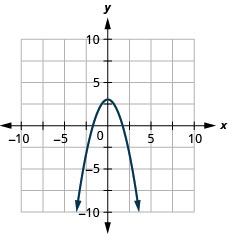
Figure 9.E.3
In the following exercises, determine if the following parabolas open up or down.
-
- \(y=-3 x^{2}+3 x-1\)
- \(y=5 x^{2}+6 x+3\)
-
- \(y=x^{2}+8 x-1\)
- \(y=-4 x^{2}-7 x+1\)
- Answer
-
2.
- Up
- Down
In the following exercises, find
- The equation of the axis of symmetry
- The vertex
- \(y=-x^{2}+6 x+8\)
- \(y=2 x^{2}-8 x+1\)
- Answer
-
2. \(x=2\) ; \((2,-7)\)
In the following exercises, find the \(x\)- and \(y\)-intercepts.
- \(y=x^{2}-4x+5\)
- \(y=x^{2}-8x+15\)
- \(y=x^{2}-4x+10\)
- \(y=-5x^{2}-30x-46\)
- \(y=16x^{2}-8x+1\)
- \(y=x^{2}+16x+64\)
- Answer
-
2. \(\begin{array}{l}{y :(0,15)} \\ {x :(3,0),(5,0)}\end{array}\)
4. \(\begin{array}{l}{y :(0,-46)} \\ {x : \text { none }}\end{array}\)
6. \(\begin{array}{l}{y :(0,-64)} \\ {x :(-8,0)}\end{array}\)
Graph Quadratic Functions Using Properties
In the following exercises, graph by using its properties.
- \(y=x^{2}+8 x+15\)
- \(y=x^{2}-2 x-3\)
- \(y=-x^{2}+8 x-16\)
- \(y=4 x^{2}-4 x+1\)
- \(y=x^{2}+6 x+13\)
- \(y=-2 x^{2}-8 x-12\)
- Answer
-
2.
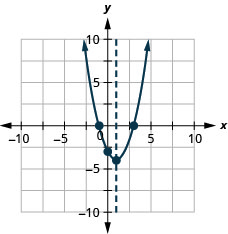
Figure 9.E.4 4.
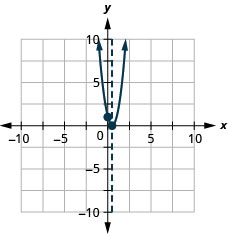
Figure 9.E.5 6.
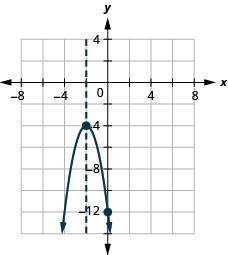
Figure 9.E.6
In the following exercises, find the minimum or maximum value.
- \(y=7 x^{2}+14 x+6\)
- \(y=-3 x^{2}+12 x-10\)
- Answer
-
2. The maximum value is \(2\) when \(x=2\).
In the following exercises, solve. Rounding answers to the nearest tenth.
- A ball is thrown upward from the ground with an initial velocity of \(112\) ft/sec. Use the quadratic equation \(h=-16 t^{2}+112 t\) to find how long it will take the ball to reach maximum height, and then find the maximum height.
- A daycare facility is enclosing a rectangular area along the side of their building for the children to play outdoors. They need to maximize the area using \(180\) feet of fencing on three sides of the yard. The quadratic equation \(A=-2 x^{2}+180 x\) gives the area, \(A\), of the yard for the length, \(x\), of the building that will border the yard. Find the length of the building that should border the yard to maximize the area, and then find the maximum area.
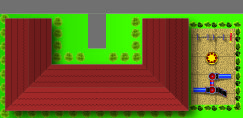
- Answer
-
2. The length adjacent to the building is \(90\) feet giving a maximum area of \(4,050\) square feet.
Graph Quadratic Functions Using Transformations
In the following exercises, graph each function using a vertical shift.
- \(g(x)=x^{2}+4\)
- \(h(x)=x^{2}-3\)
- Answer
-
2.
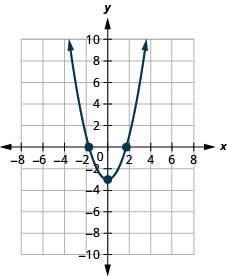
Figure 9.E.8
In the following exercises, graph each function using a horizontal shift.
- \(f(x)=(x+1)^{2}\)
- \(g(x)=(x-3)^{2}\)
- Answer
-
2.
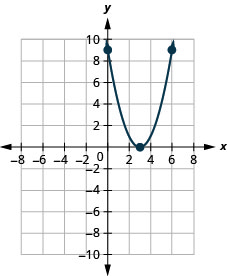
Figure 9.E.9
In the following exercises, graph each function using transformations.
- \(f(x)=(x+2)^{2}+3\)
- \(f(x)=(x+3)^{2}-2\)
- \(f(x)=(x-1)^{2}+4\)
- \(f(x)=(x-4)^{2}-3\)
- Answer
-
2.

Figure 9.E.10 4.
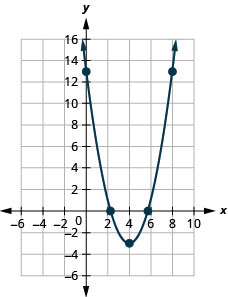
Figure 9.E.11
In the following exercises, graph each function.
- \(f(x)=2x^{2}\)
- \(f(x)=-x^{2}\)
- \(f(x)=\frac{1}{2} x^{2}\)
- Answer
-
2.

Figure 9.E.12
In the following exercises, rewrite each function in the \(f(x)=a(x-h)^{2}+k\) form by completing the square.
- \(f(x)=2 x^{2}-4 x-4\)
- \(f(x)=3 x^{2}+12 x+8\)
- Answer
-
1. \(f(x)=2(x-1)^{2}-6\)
In the following exercises,
- Rewrite each function in \(f(x)=a(x−h)^{2}+k\) form
- Graph it by using transformations
- \(f(x)=3 x^{2}-6 x-1\)
- \(f(x)=-2 x^{2}-12 x-5\)
- \(f(x)=2 x^{2}+4 x+6\)
- \(f(x)=3 x^{2}-12 x+7\)
- Answer
-
1.
- \(f(x)=3(x-1)^{2}-4\)
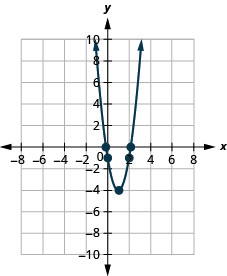
Figure 9.E.13
3.
- \(f(x)=2(x+1)^{2}+4\)
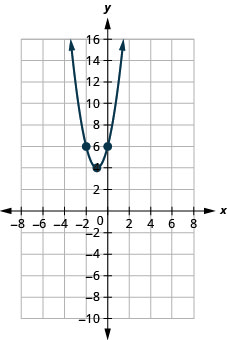
Figure 9.E.14
In the following exercises,
- Rewrite each function in \(f(x)=a(x−h)^{2}+k\) form
- Graph it using properties
- \(f(x)=-3 x^{2}-12 x-5\)
- \(f(x)=2 x^{2}-12 x+7\)
- Answer
-
1.
- \(f(x)=-3(x+2)^{2}+7\)
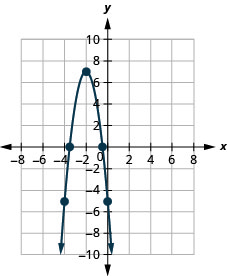
Figure 9.E.15
In the following exercises, write the quadratic function in \(f(x)=a(x−h)^{2}+k\) form.
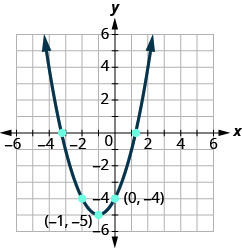
Figure 9.E.16
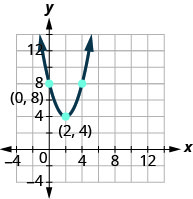
Figure 9.E.17
- Answer
-
1. \(f(x)=(x+1)^{2}-5\)
Solve Quadratic Inequalities
In the following exercises, solve graphically and write the solution in interval notation.
- \(x^{2}-x-6>0\)
- \(x^{2}+4 x+3 \leq 0\)
- \(-x^{2}-x+2 \geq 0\)
- \(-x^{2}+2 x+3<0\)
- Answer
-
1.

Figure 9.E.18- \((-\infty,-2) \cup(3, \infty)\)
3.
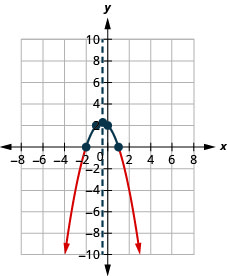
Figure 9.E.19- \([-2,1]\)
In the following exercises, solve each inequality algebraically and write any solution in interval notation.
- \(x^{2}-6 x+8<0\)
- \(x^{2}+x>12\)
- \(x^{2}-6 x+4 \leq 0\)
- \(2 x^{2}+7 x-4>0\)
- \(-x^{2}+x-6>0\)
- \(x^{2}-2 x+4 \geq 0\)
- Answer
-
1. \((2,4)\)
3. \([3-\sqrt{5}, 3+\sqrt{5}]\)
5. no solution
Practice Test
- Use the Square Root Property to solve the quadratic equation \(3(w+5)^{2}=27\).
- Use Completing the Square to solve the quadratic equation \(a^{2}-8 a+7=23\).
- Use the Quadratic Formula to solve the quadratic equation \(2 m^{2}-5 m+3=0\).
- Answer
-
1. \(w=-2, w=-8\)
3. \(m=1, m=\frac{3}{2}\)
Solve the following quadratic equations. Use any method.
- \(2 x(3 x-2)-1=0\)
- \(\frac{9}{4} y^{2}-3 y+1=0\)
- Answer
-
2. \(y=\frac{2}{3}\)
Use the discriminant to determine the number and type of solutions of each quadratic equation.
- \(6 p^{2}-13 p+7=0\)
- \(3 q^{2}-10 q+12=0\)
- Answer
-
2. \(2\) complex
Solve each equation.
- \(4 x^{4}-17 x^{2}+4=0\)
- \(y^{\frac{2}{3}}+2 y^{\frac{1}{3}}-3=0\)
- Answer
-
2. \(y=1, y=-27\)
For each parabola, find
- Which direction it opens
- The equation of the axis of symmetry
- The vertex
- The \(x\)-and \(y\)-intercepts
- The maximum or minimum value
- \(y=3 x^{2}+6 x+8\)
- \(y=-x^{2}-8 x+16\)
- Answer
-
2.
- down
- \(x=-4\)
- \((-4,0)\)
- \(y: (0,16); x: (-4,0)\)
- minimum value of \(-4\) when \(x=0\)
Graph each quadratic function using intercepts, the vertex, and the equation of the axis of symmetry.
- \(f(x)=x^{2}+6 x+9\)
- \(f(x)=-2 x^{2}+8 x+4\)
- Answer
-
2.
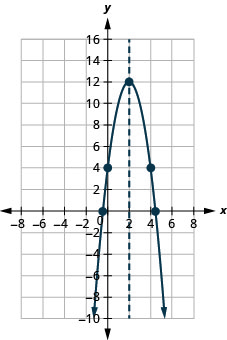
Figure 9.E.20
In the following exercises, graph each function using transformations.
- \(f(x)=(x+3)^{2}+2\)
- \(f(x)=x^{2}-4 x-1\)
- Answer
-
2.
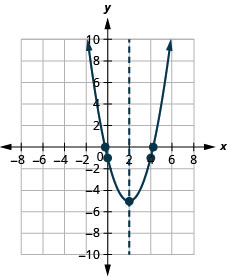
Figure 9.E.21
In the following exercises, solve each inequality algebraically and write any solution in interval notation.
- \(x^{2}-6 x-8 \leq 0\)
- \(2 x^{2}+x-10>0\)
- Answer
-
2. \(\left(-\infty,-\frac{5}{2}\right) \cup(2, \infty)\)
Model the situation with a quadratic equation and solve by any method.
- Find two consecutive even numbers whose product is \(360\).
- The length of a diagonal of a rectangle is three more than the width. The length of the rectangle is three times the width. Find the length of the diagonal. (Round to the nearest tenth.)
- Answer
-
2. A water balloon is launched upward at the rate of \(86\) ft/sec. Using the formula \(h=-16 t^{2}+86 t\) find how long it will take the balloon to reach the maximum height, and then find the maximum height. Round to the nearest tenth.


